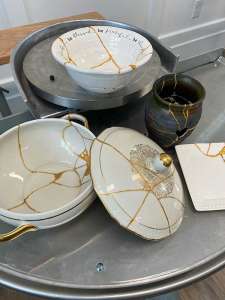A week ago, a student here at Cascade Academy asked me if we could do Kintsugi in Art Class. I wasn’t familiar with that form of art, so I looked it up. She told me that her therapist told her about it, and we should try it.
Kintsugi is a Japanese art form in which breaks, and repairs are treated as part of the object’s history. Broken ceramics are carefully mended by artisans with a lacquer resin mixed with powdered gold, silver, or platinum. The repairs are visible, beautiful, and an antidote to the culture of disposability.

The 15th-Century practice of kintsugi, meaning “to join with gold”, is a reminder to stay optimistic when things fall apart and to celebrate the flaws and missteps of life. The kintsugi technique is an extension of the Japanese philosophy of sabi, which sees beauty in the incomplete and value in simplicity.
Students went to the thrift store with mentors. They picked out their own piece that they believed would work. The students did a beautiful job considering it is very frustrating and overwhelming to put pottery back together after it is broken. It took some concentration and dedication to get the piece back together and then finally filling in the cracks with gold paint.

Kintsugi is a form of art therapy, inviting you to transcend your ordeals and turn your own gold lead. It reminds you that your scars, whether visible or invisible, are proof that you have overcome your difficulties. By materializing your story, they say, “You survived!” and bring you extra soul.




